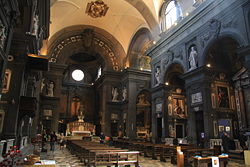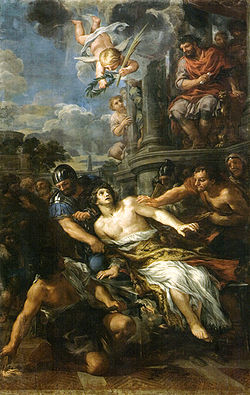
San Gaetano, Florence
Encyclopedia


Baroque architecture
Baroque architecture is a term used to describe the building style of the Baroque era, begun in late sixteenth century Italy, that took the Roman vocabulary of Renaissance architecture and used it in a new rhetorical and theatrical fashion, often to express the triumph of the Catholic Church and...
church in Florence
Florence
Florence is the capital city of the Italian region of Tuscany and of the province of Florence. It is the most populous city in Tuscany, with approximately 370,000 inhabitants, expanding to over 1.5 million in the metropolitan area....
, Italy
Italy
Italy , officially the Italian Republic languages]] under the European Charter for Regional or Minority Languages. In each of these, Italy's official name is as follows:;;;;;;;;), is a unitary parliamentary republic in South-Central Europe. To the north it borders France, Switzerland, Austria and...
, located on the Piazza Antinori.
History
The church was built for the TheatineTheatines
The Theatines or the Congregation of Clerks Regular of the Divine Providence are a male religious order of the Catholic Church, with the post-nominal initials "C.R."-Foundation:...
order, who obtained funding from the noble families in Florence, including the Medici
Medici
The House of Medici or Famiglia de' Medici was a political dynasty, banking family and later royal house that first began to gather prominence under Cosimo de' Medici in the Republic of Florence during the late 14th century. The family originated in the Mugello region of the Tuscan countryside,...
s. Cardinal Carlo de' Medici
Carlo de' Medici (1595-1666)
Carlo de' Medici was the son of Ferdinando I de' Medici, Grand Duke of Tuscany and Christina of Lorraine. Born in Florence, he had a successful career in the Church, rising to become Cardinal Bishop of Ostia and Dean of the College of Cardinals.De' Medici was raised to the cardinalate by Pope Paul...
was particularly concerned with the work, and his name is inscribed on the façade. Building took place between 1604 and 1648. The original designs were by Bernardo Buontalenti
Bernardo Buontalenti
Bernardo Buontalenti, byname of Bernardo Delle Girandole was an Italian stage designer, architect, theatrical designer, military engineer and artist.-Biography:Buontalenti was born in Florence....
but a number of architects had a hand in building it, each of whom changed the design. The two most important architects were Matteo Nigetti
Matteo Nigetti
Matteo Nigetti was an Italian architect and sculptor. He is considered the most important Baroque architect in Florence....
and Gherardo Silvani
Gherardo Silvani
Gherardo Silvani was an Italian architect and sculptor, active mainly in Florence and other sites in Tuscany during the Baroque period....
.
The church is also known as the Church of Santi Michele e Gaetano, because it was built at the site of a Romanesque
Romanesque architecture
Romanesque architecture is an architectural style of Medieval Europe characterised by semi-circular arches. There is no consensus for the beginning date of the Romanesque architecture, with proposals ranging from the 6th to the 10th century. It developed in the 12th century into the Gothic style,...
church, San Michele Bertelde, dedicated to Saint Michael the Archangel. The new church was dedicated to Saint Cajetan
Saint Cajetan
Saint Cajetan , born Gaetano dei Conti di Tiene , is a Catholic Church saint and founder of the order of the Clerics Regular, better known as the Theatines...
, one of the founders of the Theatine
Theatines
The Theatines or the Congregation of Clerks Regular of the Divine Providence are a male religious order of the Catholic Church, with the post-nominal initials "C.R."-Foundation:...
order, though the church could not formally be named after him until his canonisation in 1671.
Description
The façade, with its sculptural decorations, is atypical for Florentine churches, which had a predilection for geometrically ornamented façades.The second chapel on the left - which is the Cappella Franceschi, the Franceschi noble family of bankers and traders' chapel - contains a Martyrdom of St. Lawrence by Pietro da Cortona
Pietro da Cortona
Pietro da Cortona, by the name of Pietro Berrettini, born Pietro Berrettini da Cortona, was the leading Italian Baroque painter of his time and also one of the key architects in the emergence of Roman Baroque architecture. He was also an important decorator...
. The right transept holds Matteo Rosselli
Matteo Rosselli
Matteo Rosselli was an Italian painter of the late Florentine Counter-Maniera and early Baroque. He is best known however for his highly-populated grand-manner historical paintings.-Biography:...
's Chapel of the Nativity, with a bronze crucifix by Giovanni Francesco Susini
Giovanni Francesco Susini
Giovanni Francesco Susini was a Mannerist Florentine sculptor in bronze and marble, trained in the workshop of Giambologna....
.
In 2008 the church was entrusted to the Institute of Christ the King Sovereign Priest
Institute of Christ the King Sovereign Priest
The Institute of Christ the King Sovereign Priest is a society of priests in the Catholic Church that celebrates the Liturgy in Latin in accordance with its constitutions and founding documents. Its goals are to preserve and patronize traditional Latin Rite liturgical art and music...
, a traditional institute of clerical life.

